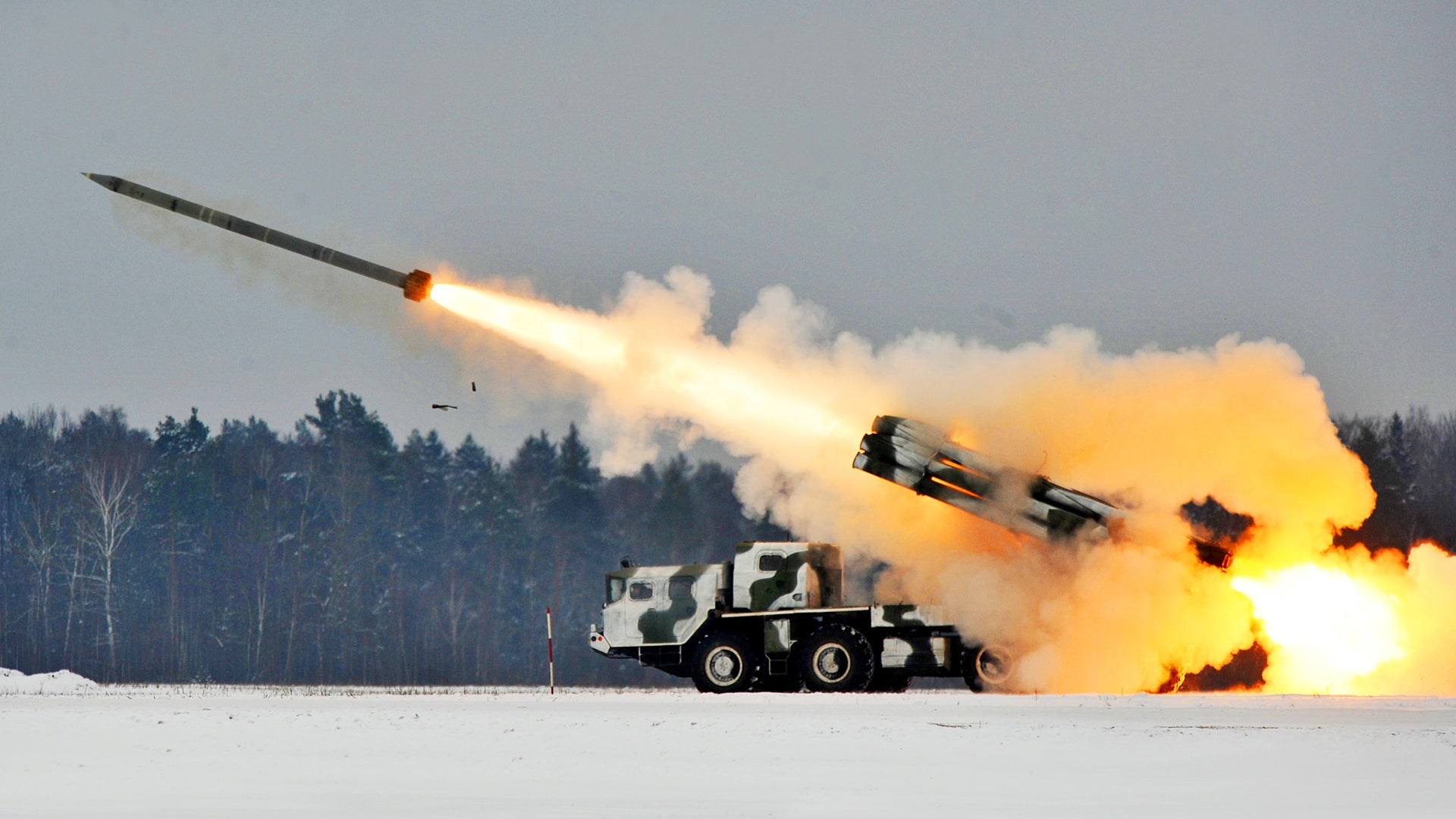Well over a week into Russia’s invasion of Ukraine, there are no signs of a conclusion any time soon, with the Kremlin’s forces meeting stubborn resistance and increasingly resorting to the shelling of cities to try and make meaningful gains. In this kind of environment, we are only likely to see escalating use of artillery by the Russians. While Moscow’s forces have fallen short in many areas, the Russian Army’s artillery capabilities are nothing short of terrifying. Here is a complete rundown of many of the systems in Russia’s possession, all of which are currently deployed to battlefield Ukraine.
Since Soviet times, artillery has played a central role in the Kremlin’s war-fighting doctrine, and it remains essential to offensive operations by the modern-day Russian military. Alarmingly, multiple reports so far have highlighted the apparently indiscriminate use of Russian offensive weapons, including artillery shells, among civilian populations, causing predictable devastation as a result. Should artillery begin to be used more extensively in these scenarios, it’s inevitable that such incidents will only multiply. In other words, Russia has the ability to unleash horrific barrages on civilian areas causing destruction in Europe the likes of which we have not seen since World War II.
Of course, artillery is not only relevant to breaking down the resistance in besieged cities. Still, the pattern of the conflict so far, and the fact that Russian airpower has apparently had limited effect on the ground war, does present the possibility that the fighting is about to enter a new phase and one that could be dominated by artillery bombardments. In particular, the Ukrainian capital Kyiv, which would be a key prize should Moscow manage to take it, could find itself on the receiving end of even fiercer artillery barrages.
With Russia already having gathered massive numbers of artillery systems in Ukraine, The War Zone has profiled systems that have so far been identified as active in the invasion operation.
Self-propelled and towed artillery
2S7 Pion/2S7M Malka
With its development starting in the late 1960s as the Soviet Army’s new large-caliber self-propelled artillery piece, the 2S7 combines a 203 mm 2A44 gun with a tracked chassis featuring all-welded steel armor. The design came from the Kirov Factory, which also produced the T-64 main battle tank.
Known initially as the Pion (Russia for peony, a kind of flower), the 2S7 entered Soviet service in around 1975 and it’s estimated that more than 1,000 examples were produced. The original model was followed by the improved 2S7M Malka that features revisions to the chassis, engine, ammunition loading system, and fire control.

Overall, the 2S7 chassis is divided into four compartments: driver’s, power pack, crew, and rear compartment, and accommodates seven crew, together with space for a man-portable air defense system (MANPADS). The vehicle has a front dozer blade to allow it to dig into its own firing position and a recoil space at the rear to provide stability.
A 2S7 or 2S7M with the ‘Z’ marking that’s applied to many of the Russian vehicles involved in the invasion of Ukraine:
Using normal ammunition, without any kind of rocket assistance, the 2A44 gun can hit targets at a range of 23 miles. Four projectiles are carried in the vehicle (increased to eight in the 2S7M), with accompanying vehicles having more ammunition inside, which is then delivered using hand carts.
The main types of ammunition include high-explosive, high-explosive/rocket-assisted (30-mile range), concrete-piercing, and tactical nuclear rounds.
The ammunition handling system can provide a rate of fire of two rounds per minute, increased to 2.5 per minute in the 2S7M.
Like most Soviet-designed military vehicles of its vintage, the 2S7 is provided with a nuclear, biological, and chemical (NBC) protection system.
As well as Russia, the 2S7 is also in service with Ukraine.
2S19 Msta-S
Developed during the 1980s, the Msta was intended to replace the Soviets’ earlier 152mm 2S3 and 2S5 self-propelled artillery pieces and retained the same caliber of ammunition. The new system was fielded just before the demise of the Soviet Union, with each battery normally having six guns. A total of three batteries would normally be found in each regiment.
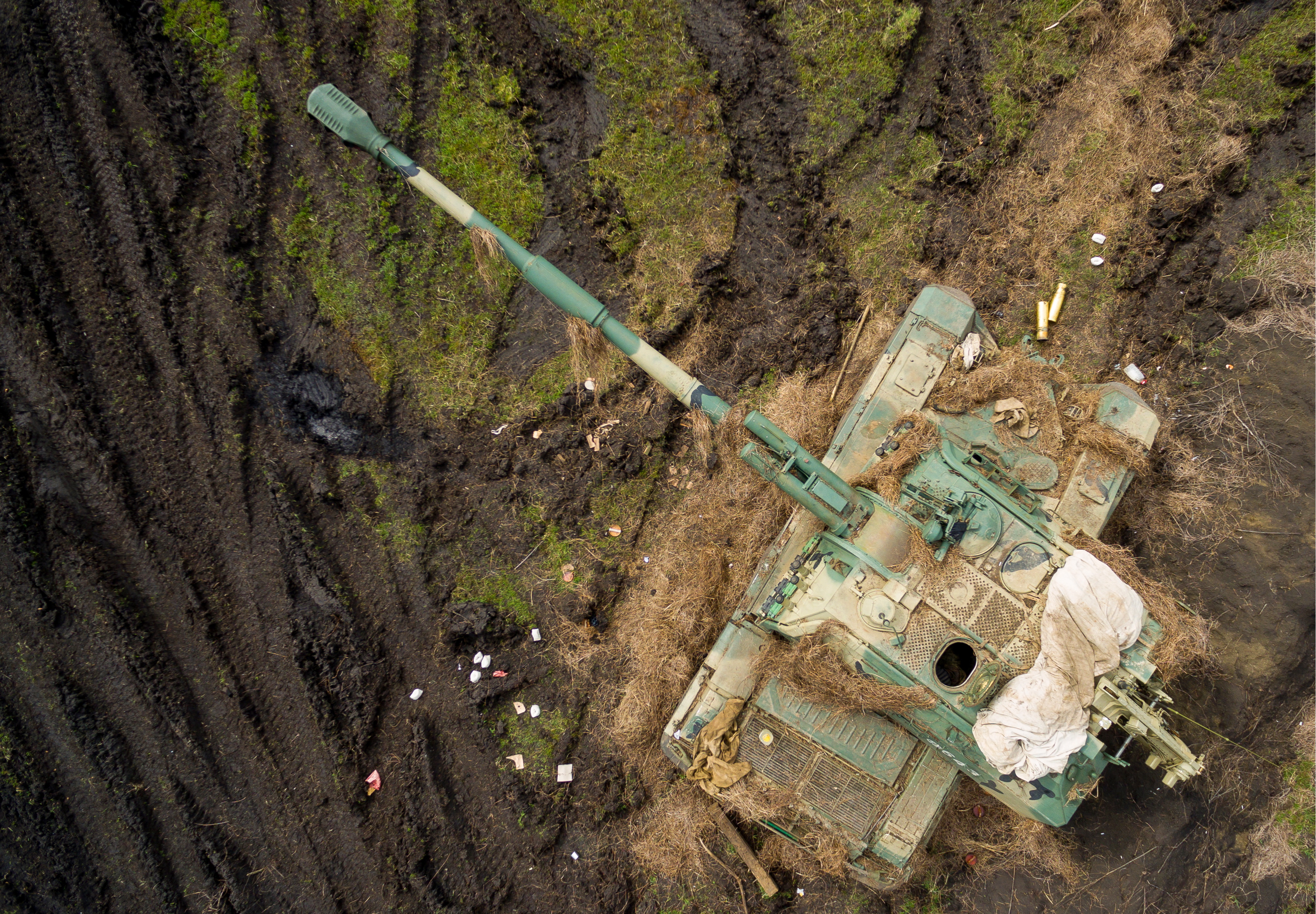
By 2020, around 600 examples of the self-propelled Msta-S were thought to have been completed, these using a chassis derived from that of main battle tanks, including the suspension and running gear of the T-80 and the diesel power pack from the T-72.
The vehicle consists of a driver’s compartment at the front, a turret in the center, and a power pack at the rear. There are five crew members. Defensive armament consists of a 12.7 mm heavy machine gun on the roof.
A front dozer blade is used to prepare firing positions and to clear obstacles.
The second video shows a Russian armored convoy reportedly attacked by Ukrainian forces and including two apparently abandoned 2S19 Msta-S:
The main gun is the 2A64 that fires a high-explosive/fragmentation round to a distance of 15 miles. Other ammunition includes a base-bleed type that extends the range to 18 miles, a sub-munitions round with high-explosive anti-tank (HEAT) bomblets, an electronic warfare jamming round, smoke, and the Krasnopol laser-guided projectile. The latter is guided onto the target in the terminal phase using a tripod-mounted laser designator. The rate of fire is between seven and eight rounds per minute. In total, 50 rounds of ammunition are carried, and the gun can be reloaded while firing, using a conveyor system at the back of the turret.

In the 2S19M version, the accuracy and speed of response of the gun are improved by the addition of an automatic gun fire-control system, of AGFCS, with a ballistic computer, satellite navigation system, and automatic gun-laying system.
The 2S19 Msta-S is in service with both Russia and Ukraine.
2A65 Msta-B
Related to the Msta-S (in which the S signifies self-propelled) is the towed version of the same 152 mm gun/howitzer, the 2A65 Msta-B. This fires the same ammunition types as the Msta-S and can similarly deliver a high-explosive projectile to a distance of 15 miles.
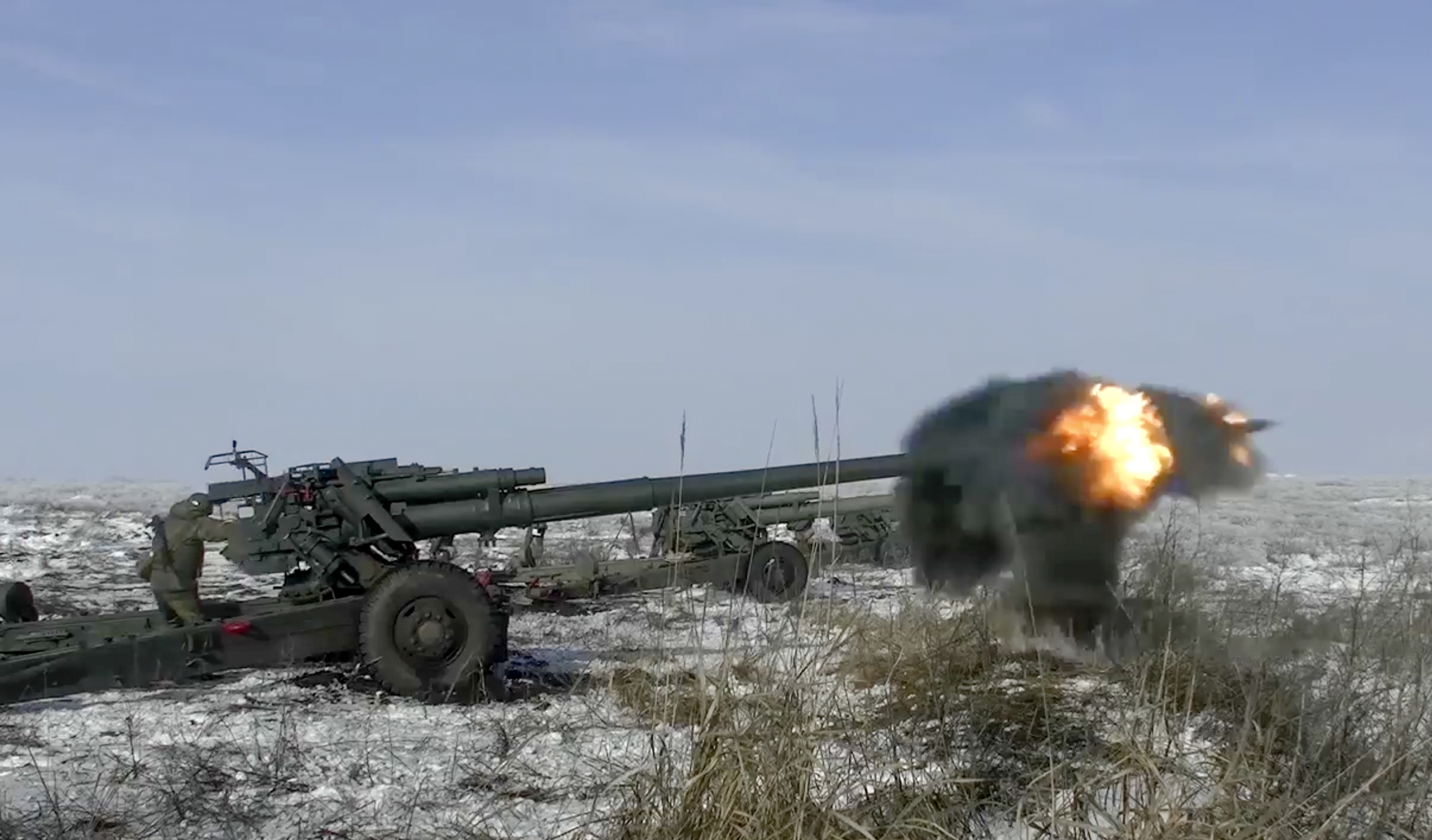
2S3 Akatsiya
The 2S3 Akatsiya (Russian for acacia, a type of plant) emerged from a 1967 requirement for a new 152 mm self-propelled artillery piece for the Soviet Army.
The 2A33 main gun is a version of the D-20 towed gun/howitzer piece and used the same ammunition, while the tracked chassis was based on that used for the Krug (SA-4 Ganef) surface-to-air missile system, but with a more powerful diesel engine and upgraded suspension.

Service entry followed in around 1971 and the 2S3 was originally fielded on the basis of 18-per tank division and 18-per mechanized rifle division. A battery normally consists of six 2S3s, with three batteries in each regiment.
The production totals for the 2S3 are enormous: around 10,000 are thought to have been produced.
The 2S3 is based around a vehicle with three compartments: driver’s, power pack, and the turret at the rear. A 7.62 mm machine gun is fitted on the all-welded steel armor turret for self-defense.
An entrenching blade is normally fitted at the front of a hull to prepare a firing position.
The rear part of the hull includes space for 33 rounds of ammunition, while the improved 2S3M and 2S3M1 can accommodate an additional 12 rounds. Normally additional ammunition is transported by a 6×6 truck and loaded via a hatch in the 2S3’s turret. Two ammunition handlers in the ammunition carrier support the four crew in the 2S3 itself.
The primary ammunition is a high-explosive/fragmentation round, with a maximum range of 11.5 miles. A wide variety of other ammunition can be fired, including high-explosive anti-tank (HEAT), high-explosive rocket-assisted projectile, armor-piercing, illuminating, smoke, incendiary, flechette, scatterable mines, and the Krasnopol laser-guided projectile.
Despite the introduction of the 2S19 Msta-S, the 2S3 remains widespread in Russian service, as has been evidenced by its appearance in the Ukrainian conflict. Ukraine also operates the 2S3.
2S1 Gvozdika
The Cold War-era 2S1 Gvozdika (Russian for carnation) 122 mm self-propelled artillery system was created at the same time as the 152 mm 2S3.
The system combines a gun that’s based on the 122 mm D-30 towed gun/howitzer together with a tracked chassis based on that of the MT-LB multi-purpose armored tracked vehicle.

The 2S1 first entered Soviet service around 1972, with over 100,000 examples thought to have been built up to 1991, when production ceased. In Soviet times, the 2S1 was issued on the basis of 36-per artillery division and 36-per motorized rifle division, while tank divisions had 72. Originally, each 2S1 battalion had three batteries of six guns each.
The all-welded steel hull features three compartments: driver’s, power pack, and the turret at the rear. The crew of four on the vehicle itself is supported by two ammunition loaders who are on the ammunition carrier vehicle.
As well as being amphibious, the 2S1 has several other novel features, including suspension levels that can be altered to ease transport in an aircraft cargo hold, and two different track options, with wider ones available for moving over swampy or snowy ground.
The 2A31 main gun is able to achieve a sustained rate of fire of five to eight rounds per minute and the vehicle carries 40 projectiles: normally, 32 high-explosive, six smoke, and two high-explosive anti-tank/fin-stabilized. The standard high-explosive round can be fired to a range of 9.5 miles. Other ammunition options include leaflet, high-explosive/rocket-assisted (range of 13.5 miles), armor-piercing high-explosive, flechette, and illumination. Another option is the laser-guided Kitolov-2 projectile, which is broadly similar to the Krasnopol described above.
Although the Russian military apparently planned to phase out the 122 mm caliber of artillery, and no direct replacement was developed for the 2S1, the system remains in use today, alongside the more modern 152 mm 2S19.
The 2S1 was built in Kharkiv and is also widespread in Ukrainian service.
The D-30 towed howitzer that provides the armament for the 2S1 Gvozdika has also appeared with Russian forces in Ukraine:
Self-propelled mortars
2S4 Tyulpan
First operational with the Soviet Army starting around 1975, the 2S4 Tyulpan (Tulip) is a 240 mm self-propelled mortar, around 400 examples of which are thought to have been manufactured.
While there have been previous reports of the 2S4 being withdrawn from Russian service, on account of its limited range and low rate of fire, it’s clearly still in service, likely now mainly using the Smel’chak laser-guided projectile.
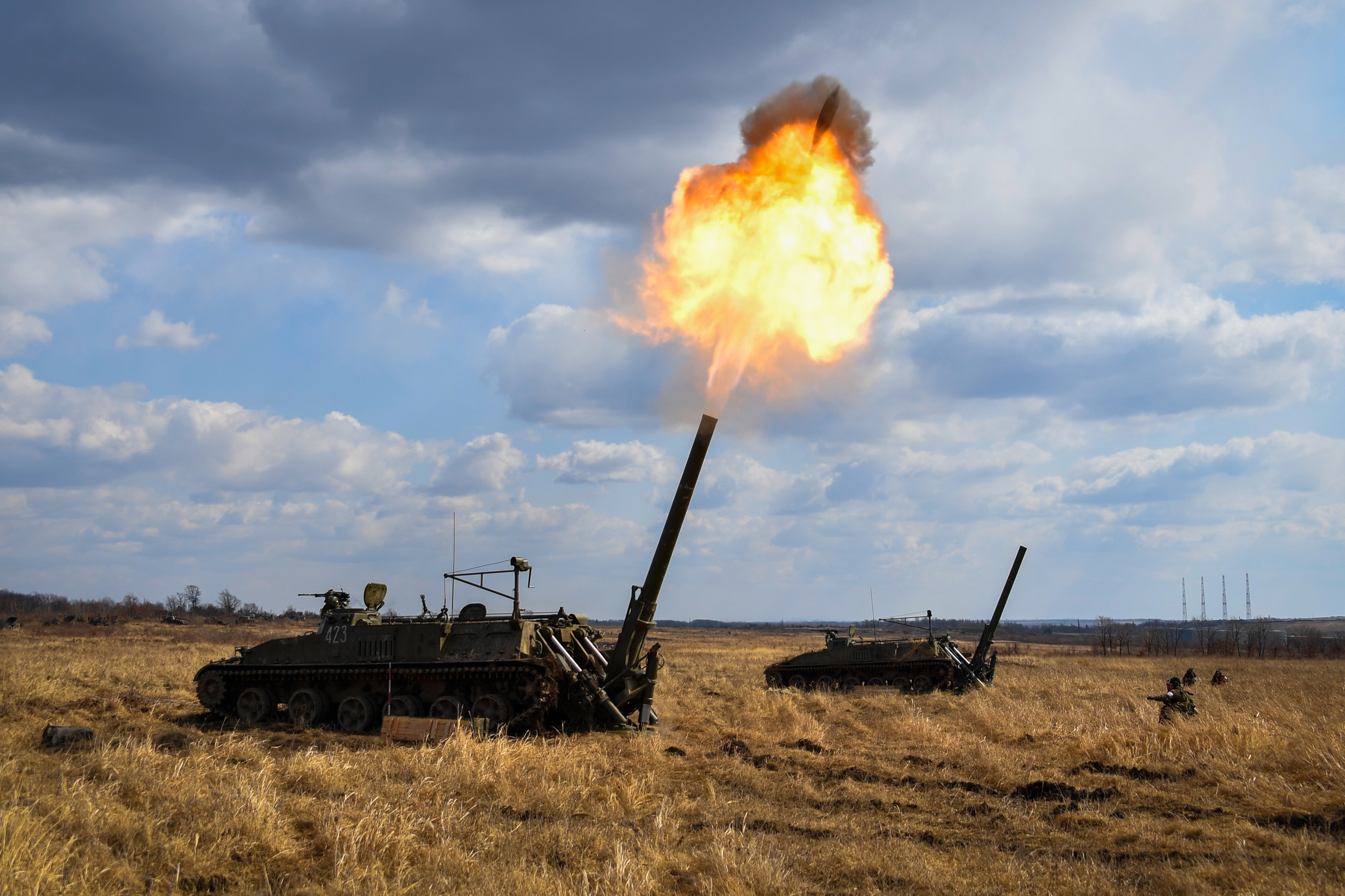
The 2S4 makes use of an adapted tracked chassis from the Krug (SA-4 Ganef) surface-to-air missile system, but with a more powerful diesel engine and upgraded suspension.
The system is operated by a crew of four on the vehicle itself, with another five soldiers being carried on the support vehicle, normally a 6×6 truck or an MT-LB multi-purpose armored tracked vehicle.
The smoothbore mortar is the 2B8, transported on top of the hull in a horizontal position, together with a large baseplate. Two drum-type magazines within the all-welded steel armored hull have the capacity for 40 mortar bombs.
The vehicle has a front dozer blade to allow it to dig into its own firing position and there is a 7.62 mm machine gun for self-defense.
The two main types of mortar bomb are conventional high-explosive/fragmentation, with a maximum range of 6 miles, and high-explosive/fragmentation — rocket-assisted (with a range of 11 miles).
The Smel’chak laser-guided projectile was developed in the 1980s and has a maximum range of 5.7 miles. This is operated in conjunction with a forward artillery observer and is guided onto the target in the terminal phase using a laser designator.
2S23 Nona-SVK
This 120 mm self-propelled gun/mortar is one of the more modern pieces of artillery deployed and entered service at the very end of the Soviet era, although initially only in small numbers.
The 120 mm mortar ammunition used in the 2S23 is also employed on two different tracked fighting vehicle chassis, the 2S9 Nona-S and 2S31, as well as by the towed 2B16 Nona-K.

Operated by a crew of four, the 2S23 is based on a modified 8×8 BTR-80 fully amphibious armored personnel carrier chassis with the mortar mounted in a turret over the forward part of the hull. Typically, the 2S23 is used by motorized rifle divisions, alongside BTRs, as well as by the naval infantry.
The 120 mm 2A60 is a rifled gun-mortar and can also be used in a direct-fire role and there’s a 7.62 mm machine gun for self-defense.
A total of 30 mortar rounds are carried in the vehicle’s all-welded steel armor hull and types include high-explosive/fragmentation, with a maximum range of 5.5 miles, rocket-assisted high-explosive/fragmentation (with a range of 8 miles), and fin-stabilized high-explosive anti-tank (HEAT). A laser-guided projectile, known as Kitolov-2M, is also likely to be available.
2S9 Nona-S
Another 120 mm self-propelled gun/mortar, the 2S9 Nona-S first appeared in the early 1980s and is intended to serve as an airborne assault vehicle. In this way, it can provide conventional artillery support, replacing towed mortar and howitzer systems, as well as in a direct-fire role as an anti-tank weapon.
Despite its airborne origins, the 2S9 is also found with regular ground forces and naval infantry, and around 1,000 examples are thought to have been produced.
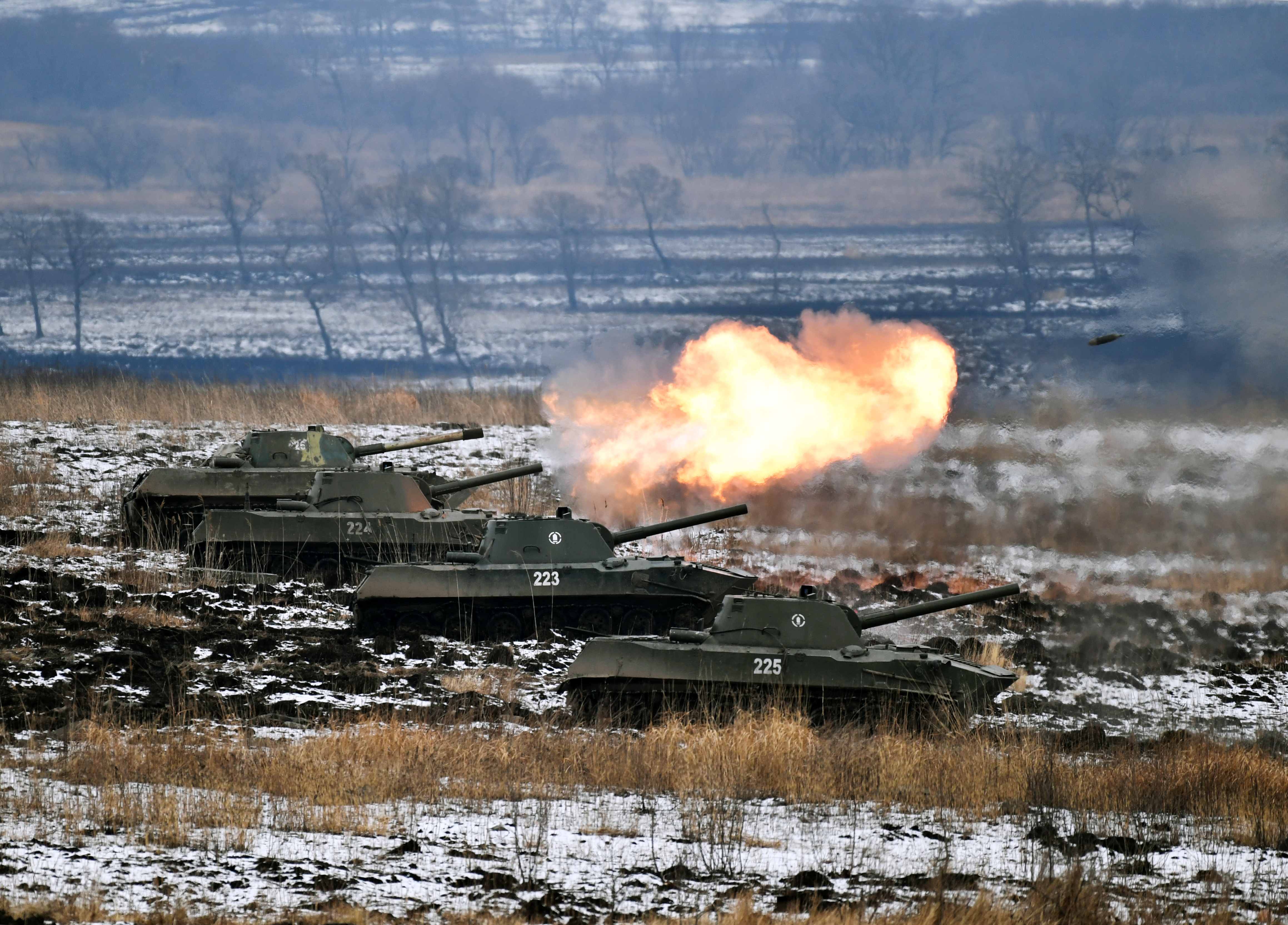
The chassis used in the 2S9 is based on the aluminum-hull, amphibious BTR-D airborne combat vehicle and has a crew of four. The hull is divided into three compartments: command compartment, fighting compartment, and power pack. There is onboard storage for 25 rounds of 120 mm ammunition for the 2A51 breech-loaded mortar, which can fire six to eight rounds per minute. The same mortar round options as for the 2S23 Nona-SVK are available, plus white phosphorous and smoke. With standard high-explosive/fragmentation ammunition, targets can be hit at a range of 5.5 miles, extended to 8 miles using rocket-assisted high-explosive/fragmentation rounds.
The 2S9 is air-transportable in Il-76 airlifters and can also be air-dropped from heights between 300 and 1,500 m.
Both Russia and Ukraine operate the 2S9.
Multiple launch rocket systems
BM-30 Smerch
The most powerful multiple launch rocket system (MLRS) in Russian service is the BM-30 Smerch, developed starting in the late 1970s and first identified by Western intelligence in 1983.
Normally, the Smerch is deployed in brigades of four battalions, each of which has 12 9A52 launchers, which are based on the 8×8 MAZ-543M chassis and each of which carries 12 tubes for 300 mm rockets that can be fired individually or in salvoes.

As well as the 12 launchers, a complete battalion also includes various command and control system units on 6×6 KamAZ-4310 chassis, maintenance and repair units on 6×6 ZIL-131 chassis, meteorological stations also on ZIL-131 chassis, and topography vehicles on 4×4 GAZ-66 chassis. Ammunition reloads are carried by transport-loader vehicles, also on MAZ-543M chassis, each with 12 rounds and a crane.
The maximum range of the 300 mm rockets is 43.5 miles, and the various different types include unitary high-explosive, sub-munitions (with 72 fin-stabilized high-explosive/fragmentation bomblets, 646 shaped-charge fragmentation bomblets), top-attack anti-armor (with five infrared-guided sub-munitions or 20 high-explosive anti-tank sub-munitions), anti-tank mine (with 25 individual mines), and thermobaric. There is also a tube-launched unmanned aerial vehicle payload, the R-90 Typchak that can operate out to a range of 43 miles and remain on station for 20 minutes.
Another family of rockets, the 9M55 series, is also available and these offer similar payloads but an increased range, up to 56 miles. There is evidence that the Smerch is using 9M54-series ammunition in Ukraine, too. This ammunition was developed for the new-generation Tornado-S MLRS and although there is so far no sign that this has been deployed in Ukraine so far, its 300 mm guided projectiles are also compatible with the earlier Smerch.
BM-27 Uragan
Firing 220 mm rockets, the BM-27 Uragan is the middle-weight MLRS in Russian service and has been in use since the mid-1970s, replacing older 240 mm and 200 mm systems.
The Uragan was designed from the outset to be highly mobile, and it consists of a 16-round launcher on a modified 8×8 ZIL-135LM chassis. The rockets can be fired individually or in salvoes.
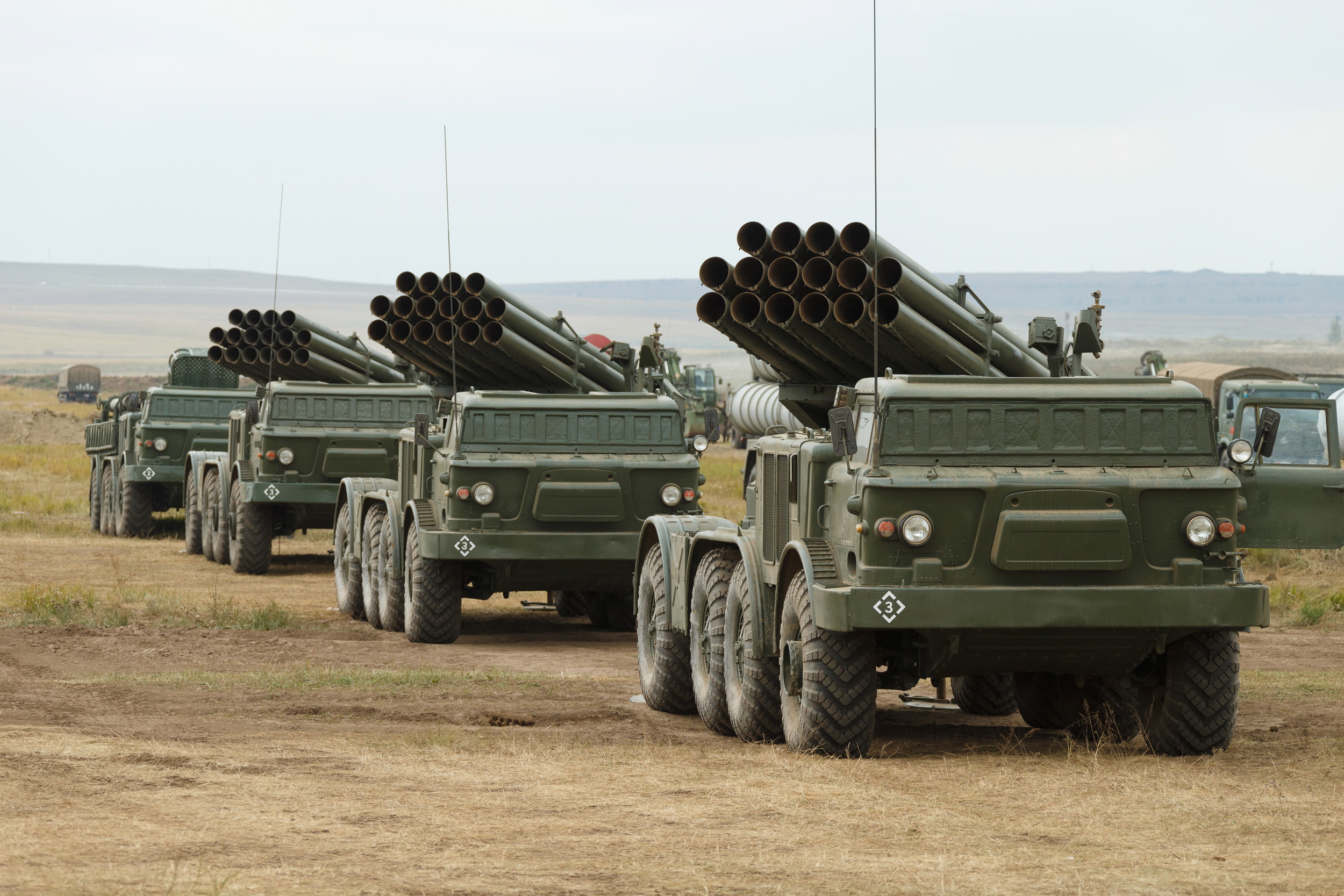
As well as the launcher vehicles, a complete Uragan battalion also includes a commander’s vehicle on an 8×8 BTR-80 armored personnel carrier chassis, a chief of staff vehicle on a 6×6 Ural-4320 chassis, three battery commander’s vehicles on BTR-80 chassis, and three battery senior officer’s vehicles on Ural-4320 chassis. Additional rockets are provided by transloader vehicles, also based on the ZIL-135LM chassis, with one or two typically being available for each launcher.
At least five types of rockets have been identified as being used by the Uragan. These have a maximum range of 22 miles and include fragmentation sub-munition cargo (with 30 bomblets), thermobaric, cluster warhead (with nine or 24 anti-tank mines).
The Uragan is operated by both Russia and Ukraine.
BM-21 Grad
Perhaps the best-known Russian MLRS is the Grad, the name of which came to prominence during the long Soviet war in Afghanistan and again during campaigns in Chechnya. The system was first deployed around 1963.
Firing 122 mm rockets, the Grad consists of a 40-round launcher on a 6×6 Ural-375D truck chassis (BM-21) or a 36-round on a 6×6 ZIL-131 truck chassis (BM-21b Grad-1).

The complete Grad system comprises the BM-21 launcher vehicles as well as ammunition supply vehicles, plus a range of different rockets that can be fired individually or in salvos, either from the cab or remotely, via a 60m cable. The maximum range of the rockets was 13 miles.
The Grad-1, with its 36 rocket tubes, was developed as a regimental-level system, in contrast to the original divisional-level Grad, and was fielded from the mid-1970s.
The Grad-1 features a slightly different system composition, with the BM-21 launcher vehicles joined by transport vehicles, and ammunition resupply vehicles. The primary rocket is the 9M28F high-explosive/fragmentation round, but other options include incendiary, flare, smoke, and anti-tank mine.
One more recent modernization of the BM-21, the Tornado-G, which is superficially similar but armed with new rockets offering improved range and more powerful warheads, has also apparently appeared in the Ukrainian conflict:
Again, the original BM-21 versions are fielded by Russia and Ukraine, the latter reportedly also operating some Grads on the more modern 6×6 KrAZ-6322 chassis.
TOS-1A
Fulfilling a unique category within the Russian artillery category is the TOS-1A, which Russia categorizes as a “heavy flamethrower,” but which is actually a unique type of multiple launch rocket system based on a T-72 tank chassis and firing thermobaric rockets. You can read more about this notorious and misunderstood weapon in this previous feature.

While it remains to be seen to what degree the above artillery systems — and potentially others — will be used as the conflict progresses, the signs are unfortunately pointing toward a more protracted campaign, with talks between Ukrainian and Russian officials so far having failed to find anything approaching common ground. As the Kremlin’s invasion continues into its second week, the slower than expected progress made by the Russian forces on the ground will surely have led to growing frustration on the Russian side.
Faced by dogged resistance, including in the key Ukrainian cities that are still holding out, extensive use of artillery, and all the horrific destruction it brings, looks like it will only become more likely.
Contact the author: thomas@thedrive.com
